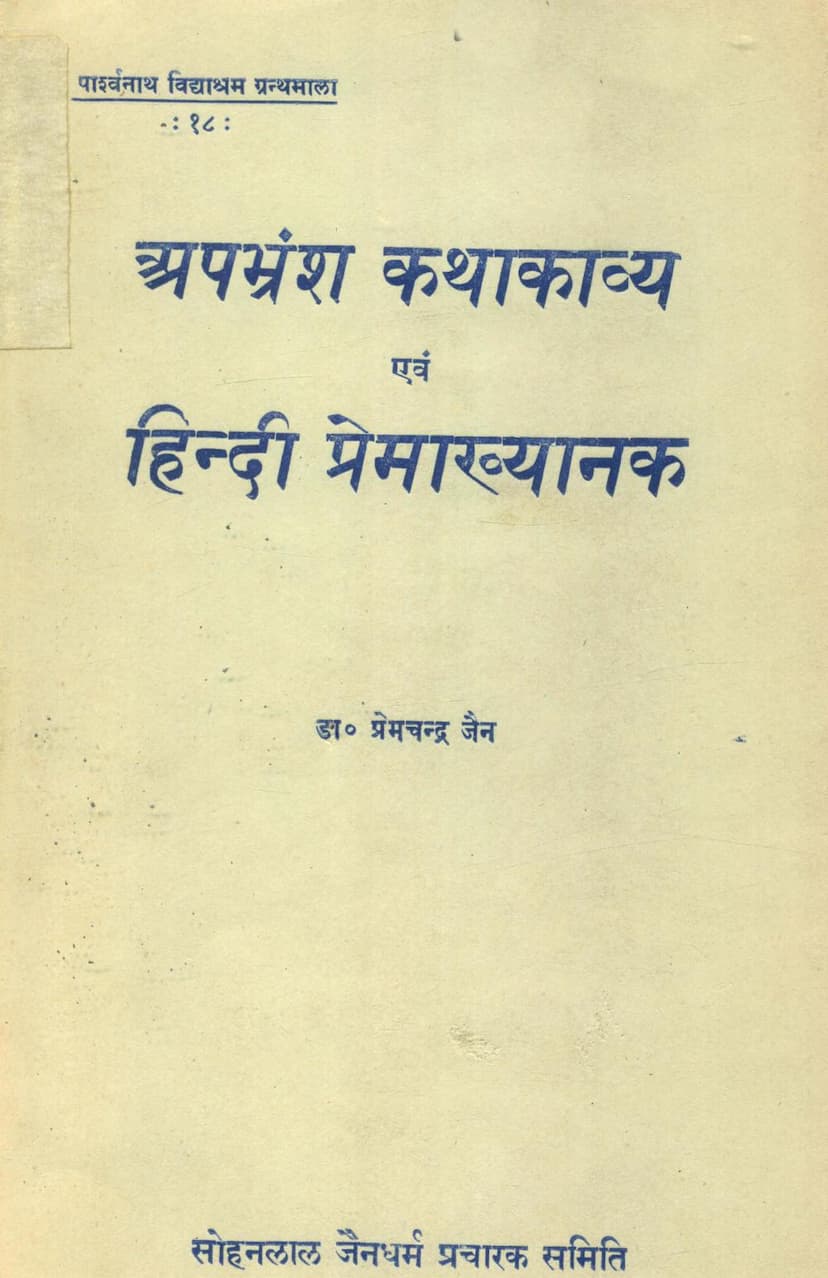Apbhramsa Kathakavya Evam Hindi Premakhyanak
Added to library: September 1, 2025

Summary
This book, "Apbhramsa Kathakavya evam Hindi Premakhyanak" by Dr. Premchand Jain, published by Sohanlal Jain Dharm Pracharak Samiti in 1973, is a comprehensive scholarly work that explores the intricate relationship between Apabhramsa narrative poetry and Hindi romantic love poems (Premakhyanak).
Here's a breakdown of the book's content based on the provided pages:
Core Argument:
The central thesis of the book is to demonstrate the influence of Apabhramsa narrative poetry (Kathakavya) on the style and structure (Shilp) of Hindi romantic love poems (Premakhyanak). The author aims to show how the literary traditions and techniques developed in Apabhramsa found their way into the later Hindi Premakhyanak literature, bridging what might seem like distinct religious and cultural origins.
Key Sections and Themes:
- Introduction & Historical Context:
- The book begins by acknowledging the vast and diverse tradition of love stories in Indian literature, from the Vedic period onwards.
- It highlights the significant literary output in Prakrit and Apabhramsa, mentioning various types of narrative poems.
- The author sets the stage by noting the common perception that Apabhramsa Kathakavyas are primarily Jain religious works and Hindi Premakhyanak are often attributed to Muslim Sufi poets. However, the book intends to challenge this binary by showing the underlying continuity in literary style and themes.
- Development of Hindi Premakhyanak:
- The book traces the historical development of Hindi Premakhyanak literature, identifying two main streams:
- Purely Indian or Hindu Premakhyanaks: These are often based on Indian folk tales, mythologies, and historical narratives.
- Sufi Premakhyanak: While influenced by Persian poetry, these works also incorporated Indian themes and styles. The author notes that Sufi poets often blended Indian and non-Indian approaches.
- It lists numerous Hindi Premakhyanak works, providing context about their themes (spiritual, purely secular love, semi-historical).
- The book traces the historical development of Hindi Premakhyanak literature, identifying two main streams:
- Shilp (Literary Craftsmanship) of Hindi Premakhyanak:
- This is a significant portion of the book where the author delves into the technical aspects of Hindi Premakhyanak.
- Shilp is defined broadly to include not just style but also plot structure, narrative devices (motifs/rudhis), descriptions of settings and objects, characterization, and the overall composition of the work.
- The author analyzes specific elements like:
- Katha-vastu (Plot): Including elements like invocation (Mangalacharan), praise of the virtuous (Sajjan-prashansa), condemnation of the wicked (Durjan-ninda), plot development, narrative expansion, the goal of the story, battle descriptions, acquisition of the beloved, and the progression from beginning to climax and resolution.
- Katha-sangathan (Narrative Organization): Descriptions of cities, forests, gardens, mountains, lakes, rivers, markets, horses, armies, weapons, thrones, etc.
- Cultural Elements: Music, arts, religious beliefs, superstitions, coincidences, and their integration into the narrative.
- Language and Style: The use of Dohe-Chaupai, Kadavaka, Ghaṭṭa, Sandhi, and chapters.
- The book provides detailed analyses of the Kathanak-rudhis (narrative motifs) in specific Hindi Premakhyanaks like Chandayan, Madhumalti (Manjhan), Chitrekha (Jaisi), Padmavat, Laxmansen-Padvati, Madhuvati Varta (Chaturbhujdas), Chhitai Varta, Rasaratan, and Mrigavati (Samaysundar).
- Apabhramsa Kathakavya: Definition, Scope, and Classification:
- This section defines and clarifies the scope and classification of Apabhramsa narrative poetry.
- It discusses the nature of Apabhramsa itself as a literary language and its connection to earlier Prakrit and later Hindi.
- It lists and briefly describes various Apabhramsa narrative works like Lilavai Kahā, Paum Siri Chariau, Bhavisayatta Kahā, Jasahar Chariau, Nay Kumara Chariau, Jambu Swami Chariau, Karakandu Chariau, Suandhadhami Kahā, and Mayanparajay Chariau.
- The author highlights the Jain influence on much of the Apabhramsa literary output, noting that even religious works contained elements of secular romance and detailed descriptions.
- Comparative Study of Apabhramsa and Hindi Premakhyanak Shilp:
- This is the core of the book where a direct comparison is made between the literary techniques and structures used in both traditions.
- Cultural Background: The author examines the socio-cultural, political, and religious contexts of the periods when these literatures flourished to understand their shared or divergent influences.
- Language: The linguistic evolution from Apabhramsa to Hindi is discussed.
- Narrative Structure (Katha-vinyas): The book compares how stories were structured, including plot devices, narrative flow, and the use of episodic elements.
- Characters (Charitra): The portrayal of heroes, heroines, and secondary characters is analyzed.
- Objective (Kathodyeya): The underlying purpose of the narratives, whether primarily didactic, romantic, or a blend, is explored.
- Descriptions (Vastu-varnan): The book compares the descriptions of settings like cities, forests, lakes, palaces, markets, and the detailing of elements like horses, elephants, weapons, and ornamentation.
- Motifs (Motif-Abhipray): The recurring narrative elements and themes (like prophecies, separations, yogi disguises, magical events, bird messengers, etc.) are compared.
- Use of Symbols (Prateek-Vidhan) and Indian Symbolism: The book investigates the symbolic language used in Sufi poetry and its connection to older Indian symbolic traditions. The author argues that many symbols, even within Sufi works, have Indian roots or were adapted to the Indian context.
- Conclusion:
- The book concludes by summarizing the findings, reiterating the significant influence of Apabhramsa Kathakavya on Hindi Premakhyanak.
- It emphasizes that while external forms might sometimes appear different (e.g., Sufi works potentially influenced by Persian masnavi), the underlying structural elements, narrative techniques, and thematic concerns often reveal a common Indian (and specifically Apabhramsa) heritage.
- The author asserts that the study of Apabhramsa literature is crucial for a complete understanding of Hindi literature.
Overall Significance:
"Apbhramsa Kathakavya evam Hindi Premakhyanak" is a foundational work that bridges the study of Apabhramsa and early Hindi literature. It demonstrates a nuanced understanding of literary evolution, highlighting how older traditions were not simply discarded but rather transformed and integrated into new cultural and linguistic contexts. The book's meticulous analysis of Shilp (craftsmanship) provides valuable insights into the mechanics of narrative poetry across different linguistic eras in India.